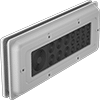Filter by
Cord OD
Color
Knockout Trade Size
Cable Tie Style
Mount Type
Cord Holding Type
Maximum Temperature
Environment
Thread Size
Minimum Temperature
DFARS Specialty Metals
Electrical
Material Handling
Containers, Storage, and Furniture
Building and Machinery Hardware
Communication
Fabricating and Machining


















































